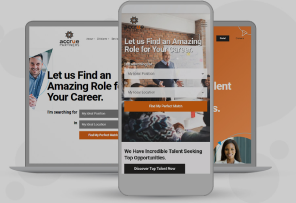Anyone who has built and launched a website has likely encountered an oft-repeated acronym: SEO (search engine optimization). And while you might not have ever done SEO yourself, you've benefited from it in the past: Every day, search engines like Google employ complex algorithms to sift through more than 400 billion web pages and deliver the most relevant results.
Website owners like you use SEO techniques and strategies to get their websites to the top of the search results for relevant user queries. But SEO is not a one-time endeavor — Google and other search engines change often, and ongoing SEO ensures your website stays in front of the people you want to reach. Just as a physical storefront requires regular maintenance and updates to stay competitive, your website needs ongoing SEO to remain visible amidst the ever-changing digital landscape.
The ABCs of SEO: What is Ongoing SEO and Why Does It Matter?
Don't let the techy jargon intimidate you. HubSpot — considered one of the gold standards for SEO and digital marketing advice — defines SEO as simply a collection of strategies and tips that "expand a company’s visibility in organic search results'' and help "drive more visitors to the company’s website, increasing their chances for more conversions which leads to more customers and more revenue."
SEO Connects the Search Engine Algorithms With Your Website's Content
Regardless of your website's goal or industry niche, all SEO techniques have one thing in common: They look at ways to optimize your website's content, keywords, and links to help search engines rank your website higher in the search results when someone searches for something related to your keywords, content, or brand name.
According to HubSpot, SEO needs to address the key factors that all search engines use to determine the value of your website's content — and therefore how high in the search results your website or specific landing page should appear:
- The intent or meaning behind why someone is searching for a specific term or question
- The relevance between what someone searches for, and the content on your website
- The quality of your content (for instance, a website about physical exercise written by certified personal trainers is deemed by Google to be higher quality than a website where the articles are written by non-experts)
- The performance of your website, such as how long it takes a page to load and whether it works well on mobile devices
Static SEO Versus Ongoing SEO: Why It Matters to Stay Fresh and Keep Your SEO Updates Current
As users' web behavior changes and technology evolves, search engines proactively adjust their algorithms.
If you aren't conducting ongoing SEO maintenance and upgrades, a well-optimized website today can quickly become obsolete tomorrow, causing your search rankings to drop and attracting fewer organic visitors. Google itself updates its algorithms several thousand times per year, including significant "major" changes every few months that dramatically change how it crawls and ranks content. For example, Google's infamous Panda update changed how it ranked how-to lifestyle content on the Internet, causing one major content publisher to lose a whopping $6.4 million of traffic and advertising nearly overnight.
How Ongoing SEO Influences Your Website Strategy
Staying abreast of changes to SEO techniques and strategies provides important guidance to your content, marketing, and overarching website strategy. For example, it can dictate or influence:
- How much content you publish, and the content's format, length, and focus
- How you incorporate other forms of media on your website, including images, video, and audio
- How you organize content on your site, including landing page layouts and your site's navigation
- What keywords and target users your website focuses on
Embrace the Power of Ongoing SEO
Caroline Forsey, an expert in thought leadership and marketing content, looked at the survey results from more than 400 of the world's leading web analysts to predict the biggest SEO trends of 2024. According to her data, some of the top changes in SEO strategies this year include:
- A heavier emphasis on expertise, meaning the content on your website should come from experts in your related field (including bylines and author bios that demonstrate the author's credentials and experience on the topic they're writing about)
- A renewed emphasis on first-person, credible content, especially as more websites generate high volumes of low-quality AI content (Google itself has announced upcoming changes to tackle low-value articles created by AI)
- A priority on websites that are deemed trustworthy, such as e-commerce sites with well-rated customer service, or content sites that do a good job of citing trustworthy research and statistics
- Bonus points on content that is creative and original and doesn't simply rehash content found on other sites
Of course, these SEO trends will inevitably change every year, and ongoing SEO will keep you competitive no matter what Google, Bing, and other search engines do. No matter your website's industry or content strategy, ongoing SEO requires that you:
- Focus on keeping your content fresh and high quality, including new blog posts or regularly refreshing and updating old product descriptions or articles
- Conduct keyword research often, since the terms or phrases that your core audience uses will evolve over time
- Maintain your website's overarching performance, such as mobile-friendliness as mobile devices evolve, and page load speed
- Build a diverse portfolio of high-quality backlinks from authoritative websites within your niche, which may include outreach campaigns, getting others in your industry to write guest blogs, and participating in online forums or communities
- Keep on top of technical and performance metrics, such as scanning your site for broken links (and fixing the links you uncover) and using tools like Google Analytics and Google Search Console to track organic traffic, keyword rankings, click-through rates, and conversion rates
- Stay on top of algorithm changes so you can adapt your SEO strategy in real-time
Some website owners think of SEO as the first step of their promotional strategy. But it's less a first step, and more an ongoing journey to ensure you, your brand, and your content stay relevant in such a competitive atmosphere. Whether you choose to go it alone and take a DIY approach to SEO, or you choose to consult with a digital marketing and SEO agency, check in often and make sure your SEO evolves as the world around you evolves.
There's an old saying, "Time kills all deals". Growing businesses can't afford to waste time with expensive, mass email lists that result in high bounce rates. Or, time-consuming, manual spreadsheets not in real-time. But, what's the best way to find new customers? Assigning and grading leads confirms which leads to pursue (and which to avoid wasting time on).
Let’s explore how to assign and track leads with CRM (so you can reach the decision-makers!).
Why Assign Leads?
"The lead generation process starts by finding out where your target market 'lives' on the web," - Wayne Davis
Assigning leads helps narrow down who to pitch your brand/business to. You can send the right campaigns to decision-makers ready to make purchases/sales.
To understand leads in the funnel:
- The Top of the Funnel attracts visitors and includes videos, blogs, newsletters, and ebooks. Anyone can complete forms as you introduce your brand.
- The Middle of the Funnel is nurturing to build relationships with your leads. Examples include case studies, demo videos, tutorials, and product spec sheets.
- The Bottom of the Funnel educates your leads on making purchases. Examples include testimonials, reviews, and sales follow-ups.
Leads and Prospects - What's the Difference?

The words 'lead' and 'prospect' differ drastically. Leads are people who don't know about your brand. Prospects are leads that you've contacted.
Here's how to differentiate them:
Leads
- Top to the middle of the funnel, vary in their qualification level.
- Receive a general form of communication.
- Several steps from becoming a customer.
Prospects
- Low to the middle of the funnel, qualified to make a purchase.
- Two-way communication exists with a rep.
- One step away from making a purchase.
Why Grade (Qualify) Your Leads?
When assigning and grading your leads, they must fit specific profiles that match criteria for your ideal customers. For example, Yale sells robotic truck lifts to facilities to help improve warehouse resiliency.
Qualifying criteria can include:
- Geography/location: Where are your leads located? This helps with 'near me' campaigns to increase local traffic to businesses (warehouse, facility, store).
- Industry-specific: What is their industry? Autonomous robotic companies sell to manufacturers and warehouses that need AGVs, AGCs, and AMRs.
- Position/Title and Experience Level: Who's the decision-maker you are targeting, (VP, Operations Manager)?
- Company Size: What is the company size, (enterprise, medium, small)? A new industrial equipment company may struggle to pitch to Fortune 500 companies. However, local or regional companies are good starting places.
Grading and Scoring Your Leads
"It's important to decide on what types of leads you want at the middle and bottom of your sales funnel," - Chris Knipper
Grading and scoring leads with points prioritize and qualifies them based on the actions they take.
Actions might include:
- Downloads: With your content marketing, are they viewing blogs and downloading white papers or case studies?
- Email Click-Through-Rates: Are they opening emails and clicking on links?
- Keyword Searches: Are they viewing different page categories?
- Visits to your pages: Are they visiting multiple pages? Spending extensive time on your site?
Scoring Examples
When scoring, rate leads based on their purchasing power. This lets sales members know how to follow-up.
Examples include:
Josh is an inventory manager for a warehouse. He's visited your site a few times and clicked on your pricing page. Score this lead higher because he is a decision-maker. Have sales reach out ASAP. Josh is likely ready to make a purchase.
Lisa is a temp for a shipping company. She clicked on a free logistics ebook and your employment page. Score this lead lower. She doesn't have purchasing power. Don't nurture this lead. She is not a decision-maker.
Assigning Leads to Sales Members
“Lead generation is a fairly core activity to marketing,” - Chris Brogan
When assigning leads, don't give low-scoring leads to high-performing deal closers. Furthermore, don't give leads ready to make purchases to new staff. They might delay or use the wrong techniques to close the deal.
Here are a few tips:
Inbound Strategies
- Who's up next? Assign leads in tandem with large sales teams and generic leads.
- Who wants this one? Ask who wants to take a lead based on a lead's particular behavior.
- Who's got the time? With leads that visit pricing pages, assign closers who can readily respond.
Outbound Strategies
- Who knows this particular industry? Assign the most knowledgeable members in a given industry.
- Who knows this customer's persona? Assign members based on lead preferences.
- Who's on this account? Assign leads by account (improves lead distribution). And, use key performance indicators (KPIs) to avoid leads slipping through the cracks!
How to Track and Manage Leads in a CRM
Lead management and customer relationship management software (CRM) work in tandem. They can help with following leads through the funnel. Features like automated campaigns and lead qualifying give your teams better insights.
Lead Generation
CRM gives creative ways to attract leads. These include social media, blogs, email campaigns, white papers, PR, and special events.
Sorting, Filtering, and Contacting Leads
CRM solutions let you quickly sort, filter, and categorize leads. Then, divide them with automation or by preference.
Nurture Your Leads
Sales members have several ways to nurture leads. These can include social media, emails or follow-up texts and calls.
Manage Leads with CRM Automation
Businesses can lose up to 80% of leads if they delay. Hence, automating lead management is crucial to saving time and capturing leads.
When automating your CRM, it:
- Works in real-time and manages lead activity 24/7.
- Automatically captures, manages, and distributes leads.
- Provides advanced reports and audits and lead tracking. Simplify emails, campaigns, and other processes.
- Gives you measurable results (CRM onboarding, CRM management, technology audits). Say goodbye to outdated data and stale reports, templates, and ad campaigns!
Turn Your Leads into Customers
Assigning leads helps you convert them into customers. However, it requires careful planning and strategy. Without an effective process in place, leads can slip through the cracks and you can miss sales opportunities. As part of your strategy, assign leads to the right team members and automate your CRM. Spreadsheets are time-consuming and prone to errors. However, CRM automation lets you send optimized campaigns and you can qualify leads faster. And, that's where Synchronicity can help.
At Synchronicity, driving growth through operational efficiency is our specialty. Let us help you keep all teams accountable for revenue - with metrics you can measure. Increase your lead conversions and maximize ROI. Connect with us today!



